Stargazing (& Shopping for Shoes) with My Mother
“That is how I remember us, styling away, off to where Miss Nightingale, clad in her long, dark woolen skirts—(it was always after Labor Day that I saw her)—and twin sets, brandished her metal foot-measuring device as a knight might his shield on the broad field of beige-carpeted showroom. And, after I had nodded mendaciously, agreeing that the dark red Buster Browns already tormenting my heels were perfectly comfortable, and all that I could want in a shoe, I was rewarded by a stop at the Walgreen’s lunch counter.”—By Jean Nolan
More Light
By Jean Carroll Nolan
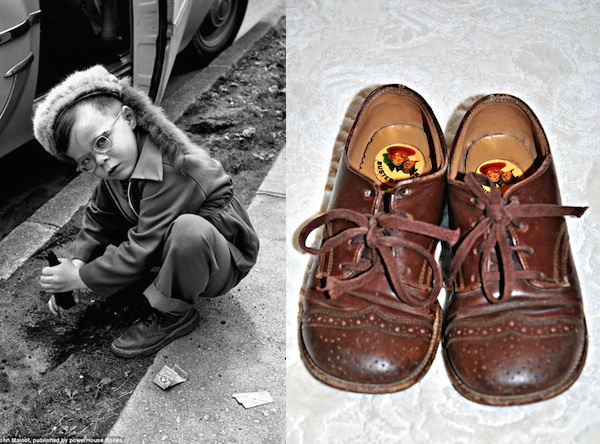
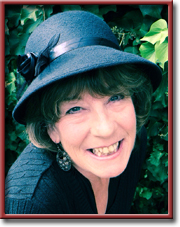 SEASIDE California—(Weekly Hubris)—10/13/2014—When I was a little girl, autumn meant school, and school meant new shoes, and new shoes meant a trip to Marshall Field’s, on State Street, and a visit with Miss Nightingale, the frightening guardian of the Children’s Shoe Department.
SEASIDE California—(Weekly Hubris)—10/13/2014—When I was a little girl, autumn meant school, and school meant new shoes, and new shoes meant a trip to Marshall Field’s, on State Street, and a visit with Miss Nightingale, the frightening guardian of the Children’s Shoe Department.
My mother had the highest regard for Miss Nightingale, almost certainly because the latter was the willing collaborator in Mom’s campaign to insure that my feet were never pinched by my shoes, my arches never unsupported, my tender soles never without the protection of Sturdy Leather, my Well-Being never sacrificed to Vanity. Buster Browns were the order of the day, for twelve long years. Always in dark red, or navy blue. A strap sewn with such determination that it would have resisted the efforts of Sinis, Bender of Pines. Tiny, punctured wounds in the toes (for aeration, I gathered, but never asked), looking almost as if they could have been made in the image of flower petals, but never quite yielding to that feminine flirtatiousness.
These were shoes that knew their purpose. Service, not frivolity. No nonsense about them.
I hated them.
I never said this, of course. Money was tight and, while I never suffered as a result, I was certainly aware that the purchase of clothes was something that had to be planned, and that the appropriate response was gratitude, not resentment. So, I looked wistfully at the forbidden shoes, the ones with thin soles and snazzy, two-color pleather-of-the-time uppers, the ones that purred “style” to me as clearly as they shrieked “cheap” to my mom, but knew, after floating one or two failed test balloons, that they were not destined to ever be mine.
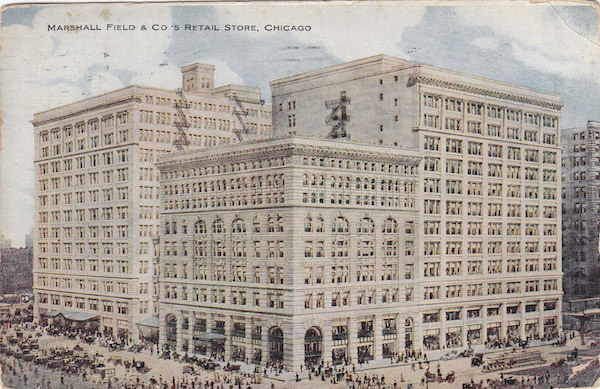
My mom, you see, born in 1915, grew up on a subsistence farm, in northern Wisconsin, and all her shoes had come from the Montgomery Ward catalogue. To hear her tell it, not one pair in umpty-dump years had ever fit her properly. My own yearly crucifixion was written by the hand of fate long before I put in appearance. Oddly, even though I knew I’d hate my new shoes, that in their efforts to be sure I was not pinched, Mom and Miss Nightingale would “fit” me in small canoes that rubbed my ankles raw for weeks, I was excited and happy about the shopping trip itself.
We rode the bus.
In Chicago, in those days. bus fare was reasonable, drivers were self-respecting and courteous, buses ran at all hours of the day and night. A dime could get you places, and the ride itself was a treat to me, as school was walking distance, we did not own a car, and simply being conveyed somewhere was novel and interesting.
The 36 or 22 bus, either one, would get us to the corner under the great Field’s clocks, and we would laugh and chatter the whole way there. It was a more formal time, of course, and blue jeans had not become the ubiquitous uniform they now are. Mom and I would dress to go shopping.
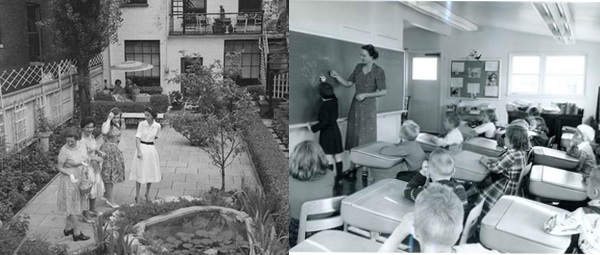
Take 1956, perhaps. The Yankees had won all season, and my dad had made some bets, and done well right along with the elegantly-garbed and menacing Bronx bombers. Shirtwaists were in, which suited my mom, whose waist and ankles were enviably slim. She had one dress I particularly recall, white, with figures in black and coppery bittersweet all over it, and a broad white leather belt. She wore it with brown heels in the warm autumn, having put away her white sandals, per the rules of the day, on Labor Day. And I believe that was the year my summer “dress up” outfit was a lavender button-up shirt with black-and-white pedal-pushers, in which I felt as chic as Grace Kelley.
That is how I remember us, styling away, off to where Miss Nightingale, clad in her long, dark woolen skirts—(it was always after Labor Day that I saw her)—and twin sets, brandished her metal foot-measuring device as a knight might his shield on the broad field of beige-carpeted showroom. And, after I had nodded mendaciously, agreeing that the dark red Buster Browns already tormenting my heels were perfectly comfortable, and all that I could want in a shoe, I was rewarded by a stop at the Walgreen’s lunch counter.
This was the pattern of the school shoe shopping trip. In December, free of the need to shop for anything (we never purchased presents downtown when I was little, but rather in the neighborhood drug store, small department store, hardware store—where art supplies were stocked—and used book store), Mom and I would go to Field’s, and lunch in the Walnut Room, with a view of the multi-story Christmas tree, and then see a movie at the Chicago Theater. But, in September, having already disbursed funds for my farrier’s visit, we drew in our horns, and had hot fudge sundaes at Walgreen’s.
And, make no mistake, hot fudge sundaes were a joy of my youth. Nothing was as good. My brother and I were sugar and carbohydrate starved. Our parents were great believers in proactive approaches to health and dentistry. We were given protein in abundance, fruits and vegetables in season, fresh dairy products, but very little in the way of starch, and trace elements of sugar. Soda pop was never allowed in our home save when ginger ale was obtained to ease a troubled stomach or to celebrate the new year. Dessert was not offered at our table.
I loved birthday parties, at which it was guaranteed that a slice of sugar, often garnished with ice cream, was headed my way. Chocolate was better than anything else, and double-chocolate hot fudge sundaes, available at soda fountains everywhere in those decadent, pre-cholesterol days, were the food of the gods. On this particular trip, I knew my mom’s mood was buoyant when she did not even hesitate about approving double-chocolate, and I began to speculate that perhaps, more lay ahead than “gustatorgy” and a bus ride home.
Indeed. After I had scraped every trace of fudge and melted ice cream off the tulip glass, after the check had been requested and paid, the tip left, we picked up our bag, which now held last year’s shoes, already forgotten, tidily tucked in the box that belonged to the new shoes on my feet, and crossed again to the east side of State Street. I held my mother’s hand as she led us to a two-story shoe store, brand new, the name of which I cannot recall. Oh, my! This was luxury. A two-story shoe store? We walked around the lower level, she looking at the displays, I gaping at the ceiling, which had a skylight through which the Indian Summer sun poured down on buttoned leatherette couches and seats. We took the escalator to the second floor, where the lights were a bit dimmer, the carpet distinctly thicker, the chairs velvet instead of plastic, and all the shoes had high heels. Really high heels. Stiletto heels. Vargas pin-up heels.
And it was here that we sat down, she glowing and I vibrating from suppressed excitement at being admitted to what I intuitively knew was a feminine mystery. For the better part of an hour, a very pleasant young man brought box after box for my mother’s consideration. She was, perforce, the queen of the multi-purpose wardrobe item, and shoes were no exception. She favored neutrals, smooth leather rather than suede, and closed toes.

But that day, she reveled in trying on red shoes, and blue, a brown and white spectator-style mounted incongruously but prettily on a spiked black patent heel, a black suede peep toe stiletto with a tiny bow at the front, a two-tone grey on grey with raised charcoal stitching. Each time, after the salesman’s hand cupping the shoe horn had been withdrawn, she would extend her leg, turn her foot, enjoy with unspoken and delicious vanity the nice line of her leg running into the throat of the shoe, and then stand, walk and turn, trying it out for comfort, she explained, though her eyes never left the mirror and even then, I knew that was a lie by the clock.
And I knew, equally, that some day, I would be able to choose the shoes I wanted. Not in time to save my dorkish, child self from exile to Buster Brown Island, but eventually. And, you know, that was sufficient. We left the store that day with two pairs of Italian heels, one a lovely taupe and gray, with beautiful detailing of rolled contrast leathers along the seams, and the other those black suede peep toes, with the little bow. She wore both pairs for years, enjoying them tremendously and never failing to garner compliments.
It would be easy, I suppose, to see this as an ultimate example of “do as I say, not as I do.” After all, she got the shoes she wanted, and I got Buster Browns that would have fit Paul Bunyan. But now, as I sit typing this, shod in a pair of black satin Fioni spike heels, it occurs to me that she gave me both lessons, and left me to reach my own conclusions. She was, in many respects, a remarkable woman, and I was lucky to have her. I wrote the following poem for her a few years ago, on Mother’s Day, to celebrate the secret girl-life she maintained with me, when we were both young.

“Stargazing”
(For Mom)
I asked my mother once, when very young,
why children fear the dark. She paused, arrested,
set down the iron with care upon its base,
and stepped back from the board, by which I knew
that what came next had weight. I should attend
with care. Her deafness daily lent my life
dimensions hearing folk could only envy,
for while she steered, without apparent effort,
faultlessly the hazardous straits of sound,
her hands had not unlearned their silent speech.
She answered with each atom in her body,
expressive as a dancer. Delight, trailing
like powdered gold from fluttering fingers,
infused the room, nodding to passing dust motes.
“Oh,” she breathed, her voice pitched to enchant,
“They’ve never seen what’s really there. Black velvet,
with diamonds scattered everywhere. That’s all.”
She gazed with pleasure up to our Aegean ceiling,
inviting me to join her contemplation
of constellations only we perceived.
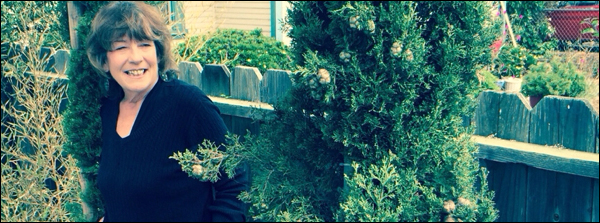
9 Comments
Anita Sullivan
Thanks for this lovely set of memories, Jean! My own childhood shoe nemesis was the black “rubbers” I was forced to put on over my shoes. This made me feel awkward and ugly, plus they were the devil to get off and on. I look forward to your future posts, and I’m glad you’re part of the WH group!
Elizabeth Boleman-Herring
In the early 60s, Jean, we shared the same Chicago, from ever-so-slightly-different perspectives. I, too, shopped for school shoes at Marshall Field’s, but it was the uniforms–the navy wool skirts–that gave ME such fits. This essay and poem re-opened doors and windows I no longer remembered exist(ed) in our shared house; and so lovingly and with such wit re-opened them. Thank you, Jean!
Jean Nolan
Thank you, Anita, for the welcome and the kind words. And, oh! Do I remember those rubbers – and you are right. They were incredibly difficult to get off and on. Did you also suffer with snow suits, when young? I believe one of the reasons “A Christmas Story” is one of my favorite movies is the scene in which a young child falls while wearing a snow suit, and is, as I recall being, utterly helpless to recover. It is very funny now, but was not, when I was the victim of protection from the elements!
Jean Nolan
Elizabeth, it was a time out of mind, was it not? So much good, so much bad – and so very different. I had one straight navy wool skirt, and one a-line navy blue skirt. Gack. I was so “off” blue by the time I dropped out. Then, of course, I went to work for Avis Rent-a-Car, and learned to detest red!
Kate
To say that I was transferred to another time – a day in the life ..to say that I felt that I was there – that many of us were there sharing in the experience and the joy that such a day and life had brought. Dearest Jean – it is beautiful, thoughtful and thought provoking. I have read it and re-read it…my chest is so full – to say that I am “proud” of you is an understatement. Thank you for blessing us all with your remarkable gift. I will look forward to your next post. Much love Kate
Alan Ichiyasu
WELL…THERE’S NOTHING LEFT TO BE SAID. BRAVO, IRISH, BRAVO!
LUV,
PB
Alan Ichiyasu
IRISH: THAT WAS ME IN THE COONSKIN HAT AWAITING DEPARTURE FOR HAVANA AT MIDWAY AIRPORT. THAT’S WHEN RAY MILLAND & I GOT TIGHT.
PB
Jean Nolan
Kathryn, thank you so much! I greatly appreciate you coming over here to comment, and appreciate the encouragement. If one wishes to write, it’s handy to be born into an interesting family!
Jean Nolan
Alan, I figured you were the kid in the coonskin hat, but had NO idea, until now, that you were the prompt for “The Lost Weekend”! Thank you for coming over, and having a cup of coffee with me. The (Dutch) door is always at least half open.